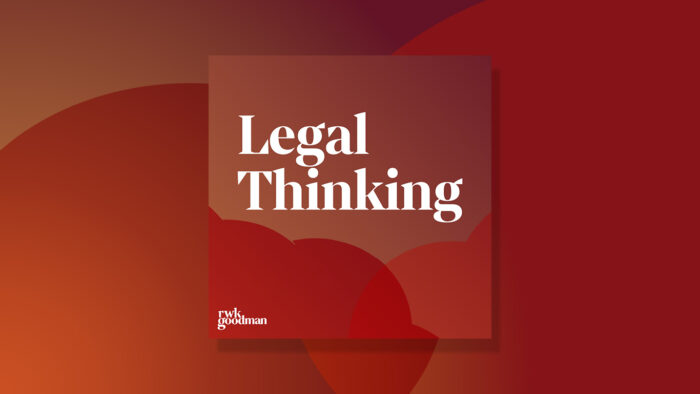ESG and children’s services – what operators need to know.
This podcast transcript has been edited in places for readability. You can also listen to our podcast on your podcast platform of choice - find it here >
Today we’re joined by Rob Walton from our Real Estate team and specialist in the health and social care sector, as we continue our series on ESG in health and social care. So today Rob will be guiding us through ESG for children's services.
Rob, let's start with the basics - what are children's services?
Yeah, so we’re looking through the lens of the health and social care sector. This also encompasses the education sector for us.
We’re not looking at things like primary schools, secondary schools or further or higher education. We’re focusing on things like early year provision, children’s homes, special schools, supported accommodation and also fostering agencies.
Okay. And what sort of work do you do in this area?
Yeah, so as said our clients include all the above. In terms of the sort of work that we do, we do things like sales and acquisitions, development leases and construction, refinancing, employment work, Ofsted regulation, challenging Ofsted inspection reports, advice on local authority fees, safeguarding, debt recovery, data protection, shareholder agreements, litigation, all sorts of things really, you name it, we tick the box.
Why is ESG important for these providers specifically?
Yes – well, we’ve heard from the other podcasts that ESG is important to all health and social care providers. However, particularly in this area given the profound ethical, social and operational responsibilities organisations – it’s quite crucial for them.
So just looking at like a basic summary, you’ve got things like social responsibility, children’s services to have highly vulnerable individuals making it essential to prioritise safety, well-being and high-quality care. Equality, inclusion, ensuring access to care for children with diverse backgrounds and needs and disabilities or socioeconomic challenges. And also they’ve got the community impact that schools and early years provisions have within local communities.
We look at things like governance – you’ve got things like safeguarding and compliance, ethical standards as well as stakeholder trust – that’s talking about parents, guardians and public institutions.
We’ve then got things like environmental responsibility, having sustainable practices in their facilities, providing – what’s not often talked about is providing role modelling, actually for children – giving positive role models. And then again, community sustainability, as we’ve mentioned.
When we’re looking at these sector specific factors, we’re looking at the investment in ESG and the children’s services directly impacts societal outcomes as early childhood care and education are linked to better health, economic and social results over the lifetime. Other things such as reputation, funding as well as providers to demonstrate these commitments a better position to attract funding and maintain public trust.
Where does this differ from, for example, elderly care, especially in the context of regulation?
Yeah, so if we just look really – kind of that main difference is going to be the regulatory aspect. In elderly care, for example, you’re looking at CQC as your main regulator, whereas with educational aspect and children’s services you’re usually looking at Ofsted when there’s an education factor. So there’s an interaction between the ESG principles and Ofsted, so there’s UK’s regulatory body for inspecting children’s services – it’s fairly deeply entwined. And so we look again – just ticking the boxes for the EDS and the G.
If we look at environmental, Ofsted will be evaluating the safety and suitability of such physical environments and the maintenance and cleanliness of facilities. This includes not only energy efficiency but also waste reduction and it’s looking to create safer, healthier spaces. There’s also ecofriendly practices to indirectly enhance a settings reputation. So there’s also education on sustainability as well. So – like nurseries and schools will be teaching children about the environmental, sustainability and they can align with Ofsted’s evaluation of how providers promote personal development, particularly fostering an understanding of responsibility.
Moving over to things like social, we’ve got wellbeing and safeguarding. So safeguarding is a key factor in this area. It’s promoting the children’s welfare – that’s central to Ofsted inspections. The social pillar of ESG focuses on high quality care, equality and inclusion, which are essential for meeting those criteria. Then again, we’ve got the community and stakeholder engagement. So the ESG driven efforts will provide a strong relationship with parents, guardians and local community support, Ofsted’s emphasis and how well a setting engages with stakeholders.
And then moving to governance, we’ve got compliance and accountability. So ESG – we focus on transparency, ethical practice and compliance. Values are directly assessed by Ofsted under their leadership and management. Provides a strong governance system i.e. rigorous staff training and safeguarding policies, are better equipped to meet these standards of Ofsted. Ofsted are also looking for continuous improvement to monitor and improve their improvement, which is how an ESG policy really works. So for example, clear policies, quality staff development and resource allocation can align with those goals. So really you’re looking at these in alignment in objectives.
So in summary the ESG principles are going to reinforce and strengthen the areas assessed by Ofsted, helping these organisations not only comply with the standards but also excel in creating these sustainable and inclusive environments for children.
How does the Environment aspect apply to children's services more specifically?
Yes, so there’s a number of different ways it applies.
So, first of all we’re looking at facilities and operations. So children’s services often involve managing the physical environments. So we’ve got things like energy efficiency, which we’ve talked about before such it’s just reducing energy consumption of facilities by using renewable energy sources – energy efficient lighting and proper insulation, and your smart thermostat and energy monitoring systems.
We’ve got the sustainable building design – because obviously with new creation of buildings, we’re looking at the design or retrofits with solar panels, rainwater harvesting – anything to contribute to sustainable operations. Special schools and large residential facilities can particularly benefit from reduced utility costs and improving their environmental performance. We’ve got waste management as well. And then there’s auto water conservation.
So the next one we’re looking at will be promoting a healthy and sustainable environment, because the physical environment in children’s services will directly affect the health and wellbeing of the children they support. So then we’re looking at things like air quality, ensuring that by reducing pollution, using non-toxic cleaning products and even things like incorporating indoor plants to create healthier spaces for children, particularly those with asthma or allergies, promoting green spaces, outdoor areas with gardens and natural play. It also promotes sustainability but also enhances the children’s mental and physical wellbeing. And allied to that you’ll be using sustainable materials as well.
The next one would be environmental education. So the services have quite a unique opportunity to teach environmental responsibility, fostering these lifelong habits. So you want to try and integrate this into the curriculum with various sustainability topics. Things like experiential learning – like hands on things like gardening, recycling projects or nature walks. And then there’s something we mentioned briefly before is role modelling. The staff and the care givers demonstrating their own sustainable behaviours.
The next we’re looking at is community impact. So the children’s service – they often operate within the local communities and their environmental practices have a broader societal impact. So that’s where you can have things like partnerships with local sustainability initiatives, collaborate with local councils or charities or businesses for recycling, tree planting or community clean-up – and also local sourcing trying to purchase locally sourced food and materials.
The next one would be climate resilience and risk management. So they need to go and prepare and mitigate on their operations and- so that’s really kind of larger thoughts but in terms of – one’s called disaster preparedness. And that’s something like flood proofing buildings and cooling systems for heatwaves and ensuring continuity of care. So that’s all in your risk assessment plan. There has to be things like resource scarcity planning as well and how to manage efficiently your resources, such as your water your food and energy efficiency.
The next one that comes up would be your regulatory and funding implications. So sustainability is increasingly emphasised by regulators and funders. So it makes it a priority. This is through things like compliance, your environmental regulations, meeting standards of energy use and waste disposal – and something we briefly mentioned before – it doesn’t always come up in this sector, but that would be attracting green funding, demonstrating a commitment to sustainability and opportunities for grants, investments or partnerships with environmentally conscious organisations. So we just look at sector specific applications from ones we’ve talked about before with early years and nurseries – they’d be things like using non-toxic materials, ecofriendly toys and basic sustainability concepts for young children. The special schools will be tailoring environmental education to children with additional needs and ensuring accessibility in their design. For children’s homes and supported accommodation we’d be creating homely, ecofriendly environments which balance comfort with sustainability and for fostering agencies, we’d be encouraging foster families to adopt green practices, teaching foster children about sustainability, so try and bring it all in together really.
And the Social aspect of ESG, how does that apply?
Yeah, so there’s a number of different aspects again, as with E, but referring now to the social aspect.
So your first one would be things like safeguarding and child protection – which should be top of your list. So there’s a core responsibility, safeguarding is a cornerstone of all children’s services. So providers must ensure their safety and protection of children. So they need robust safeguarding policies and staff training to ensure compliance with legal requirements and build trust with the families. And obviously we’re going back into Ofsted as well in terms of regulation. Throughout that, there must be monitoring and reporting, establishing clear procedures for identifying addressing risks to children, introduce mechanisms for whistleblowing, reporting concerns and ensuring accountability.
The next one we’d look at would be equality, inclusion, diversity. So we’re promoting equal access. So children’s services must ensure that there’s equal access for care and education for all, regardless of their socioeconomic status, disability or ethnicity. For example, fostering agencies and special schools must tailor service to meet the diverse needs of their children with disabilities or from minority communities. There also should be some cultural sensitivity, providing culturally competent care i.e. celebrating diverse traditions or accommodating dietary and religious needs. And then that’s all held up by a robust anti-discrimination policy to ensure the staff and children are protected from discrimination.
Next one we’ll probably look at would be supporting mental health and wellbeing. So for children when looking at their emotional needs, the children in care or supported accommodation may have experienced trauma. Service you provide mental health support throughout trained professionals and therapy programmes or partners with external specialists and promoting emotional intelligence and resilience, particularly in early years settings as it lays a good foundation. But it’s not just the children, it’s also the staff wellbeing. So you want to ensure your staff mental health is supported through manageable workloads, fair wages and access to mental health resources. This will directly impact the quality of care. Looking then at the quality of education and opportunities – so early years and special schools, we’re looking for high quality and inclusive education. For example early years providers focus on school readiness – while special schools delivered more tailored education. The ESG principle is there to encourage an ongoing evaluation and improvement.
Another one we’d be looking at would be supporting the families and carers as well. So parental support – so nurseries and early years settings often play a dual role in supporting both children and families, includes providing parenting workshops, flexible hours for working parents and resources for low income families, for fostering residential carers – they’ll be training and ongoing support for them to ensure they can meet the emotional, practical needs of the child in their care. And that’s where there’s also going to be collaboration with external agencies, such as social services and healthcare providers and education professionals.
The next fact will do some staff development and fair treatment. So we’re looking here at training and development for staff, ensuring best practices and safeguarding. And also part of that you’d probably have an employee voice scheme to encourage staff to provide feedback and participate in the decision making process. We’ve already briefly talked about community engagement and social impact as well. And then you’ve got other things such as how you’re going to measure your societal impact. So thinking of tracking your outcomes, you’ve got metrics such as in the school educational attainment, placement, stability, mental health outcomes, satisfaction levels of children and families and staff and using a continuous feedback approach.
So if we’re looking at the specific areas that we’re working for early years and nurseries, we’re looking at concentrating on providing equitable access for childcare for working families, promoting early social and emotional development. Special schools – we’re looking more at tailoring their education and therapies to meet the diverse needs of children with disabilities. Children’s homes supported accommodation will be ensuring safe, nurturing environments and preparing young people for their independence.
And so finally the G - the Governnance point of ESG; how does that apply?
Yeah, so effective governance is trying to ensure that these services maintain high standards of care, comply with their regulations and act in the best interests of all the stakeholders.
So number one, again, would be the safeguarding and risk management. So that’s your core responsibility to ensure that the strong governance, to have a robust safeguarding policy and procedure, and the organisation should have clear protocols for identifying, reporting and addressing those concerns. There needs to be risk assessment. Effective governance includes ongoing risk assessments to identify vulnerabilities such as staff shortages, financial instability or health and safety hazards.
Then we’ve got regulatory compliance – so legal and regulatory requirements. So that’s where we’re looking again at Ofsted, the Department of Education and local authorities. Governance ensures adherence to standards in areas such as child welfare, health and safety and staff qualifications. This is accompanied with transparent reporting and also data protection – because safeguarding children’s personal data is critical. The governance policies must ensure compliance with the data protection laws such as GDPR, particularly when handling sensitive information about children and families. It should be led by ethical decision making, prioritising the child’s interests. The governance framework should ensure decisions prioritise the well-being, safety and development of children of any financial or operational convenience and it should be fair and transparent. So the ethical governance should promote fairness in resource allocation, decision making and dealing with the stakeholders.
Next we move on to leadership management. So there’s board oversight. It needs a strong governance oversight by qualified and diverse Board of Leadership team that should be fully qualified. They need to be leaders in children’s services, must demonstrate expertise in their child development, safeguarding and ethical management and training where necessary, and they should be always monitored. So the performance monitoring, using setting and tracking key performance indicators relating to child outcomes, star performance and operational effectiveness.
The next one that’s always important is financial governance stability. There should be budget management strong financial governance to ensure the funds are allocated properly, fraud prevention schemes and obviously long-term planning, strategic governance for financial stability over a long period of time, even when we have economic challenges as we’ve had recently. Then we’re looking at other things such as staff recruitment, retention and training. Stakeholder engagement, which would be the one we’ve talked about before in terms of building trust with third parties.
Other things that can come up as well is something called crisis management resilience. So that’s something within governance where you’re being prepared. So strong governance including contingency plans for any emergencies, having rapid responses into any safeguarding issues which can arise. This all has to be monitored and the impact devalued through outcome tracking.
And finally, we’re just looking at some of these sector specific applications. We’re looking at early years and nurseries. We’d have the governance to ensure compliance with child to staff ratios, curriculum standards and safety regs and promote inclusive practices. For special schools and these frameworks to be addressed to the unique needs of the children with disabilities to ensure ethical treatment and access to specialised resources. Children’s homes – we’re looking at safeguarding, emotional wellbeing and ensure a stable, nurturing environment. Supported accommodation for example to ensure the older children receive age-appropriate support to prepare for independence while safeguarding their welfare.
So what does the future hold in the sector relating to ESG? Is there anything that children's services might need to look out for on the horizon?
Yeah, so I think it’s set to evolve fairly significantly as society, regulatory and stakeholder expectations around things like sustainability, equity and ethical practice are only really going to increase. So I think there’s a few things probably on the horizon to look out for.
I think the first one would be enhance regulation, scrutiny in ESG reporting. I think regulatory authorities such as Ofsted in the UK and obviously one this has happened literally yesterday was with regards to children’s homes. So there’s some increased regulation there as well. So in terms of try and prepare for all those increased regulation, you want to be developing a systems to track and report your ESG metrics and stay ahead of the compliance requirements by embedding ESG into your operational and strategic plans.
I think there’s going to be a growing emphasis on environmental sustainability. So I think there’ll be an increased focus on reducing carbon emissions and environmental footprints. I think there’ll be a higher demand for green facilities such as ecofriendly buildings, and there’ll probably be an integration of environmental education into the curriculum. In terms of preparing for this, you want to conduct environmental audits, you want to invest in energy efficient infrastructure and incorporate environmental topics into the children’s learning experiences. The next one will probably be the evolving social expectations. So I think there’ll be greater emphasis on addressing social inequities, particularly for disadvantaged groups such as children with disabilities or those in care and marginalised communities. There’ll be increased focus on mental health not just for children but also staff and rising expectations for diversity, equality and inclusion initiatives. To prepare for this, you want to be strengthening your safeguarding and mental health support systems, implementing policies to ensure access to services and promoting staff diversity and training teams and cultural competence.
The next one, which we actually briefly talked about in a previous podcast, the innovations in technology. So I think there’ll be a growing use of technology for service delivery, monitoring and governance. Increased emphasis on data security and probably more emerging tools for tracking and reporting on ESG policies in the first place. So to prepare for this, we are investing in secure, user friendly technology to support this, they’ll be training staff to be more digitally literate and also updating your data protection practices and exploring any ESG focused tech solutions.
In terms of any workforce challenge and opportunities, I think the main one is probably recruitment and retention, probably a shift also towards ethical employment practices. So again, preparing for this, you’re investing in staff, staff wellbeing, professional development and competitive compensation packages, embedding your ESG training to the staff, onboarding and continuous professional development and trying to foster a workplace that prioritises inclusion, collaboration and ethical behaviour. So probably the last one would be the long-term cultural shift towards ESG.
So I think ESG principles are increasingly embedded in the core ethos of organisations affecting all their operations. So to do this overall, you want to be treating ESG as your strategic priority rather than a compliance requirement. You want to embed the ESG values into your organisational culture, ensuring you get buy in from your leadership, your staff and your stakeholders and then regularly review and adapt your strategies to reflect changing priorities and your expectations. I think the future of children’s service in the context of ESG involves navigating a landscape of higher expectations, evolving regulations and shifts in society really. So I think the organisations need to prepare proactively embedding these ESG principles into their operations.
Rob Walton, thank you for your time.
Listen to our series on ESG in the health & social care sector.

Subscribe to Legal Thinking
Want to hear more from our podcast?
Find out where you can subscribe and check our our back catalogue right here on our website.
More insights from our health & social care team
View more articles related to Health and Social Care






